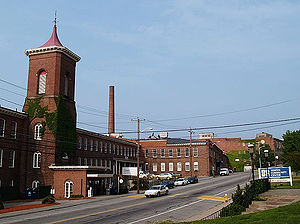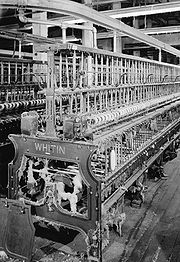
Whitin Machine Works
Encyclopedia

Mumford River
The Mumford River is an river in south-central Massachusetts. It is a tributary of the Blackstone River.The river rises from its headwaters in Sutton and Douglas at Manchaug Pond and flows east in a meandering path through a series of ponds , and joins the Blackstone River in Uxbridge.The river...
in South Northbridge, Massachusetts
Northbridge, Massachusetts
Northbridge is a town in Worcester County, Massachusetts, United States. The population was 15,707 at the 2010 census. The Northbridge Town Hall is located at 7 Main Street in Whitinsville. The town is now a part of the Blackstone River Valley National Heritage Corridor, of the National Park...
. The village of South Northbridge became known as Whitinsville in 1835, in honor of its founder.
The Whitin Machine Works became one of the largest textile machinery companies in the world. Known as The "Shop" to locals, would operate well into the 20th century, long after many of the New England
New England
New England is a region in the northeastern corner of the United States consisting of the six states of Maine, New Hampshire, Vermont, Massachusetts, Rhode Island, and Connecticut...
mills had moved South. By 1948, The company was operating at peak capacity, employing 5,615 men and women. The Shop was the center of life in the village of Whitinsville, Massachusetts
Whitinsville, Massachusetts
Whitinsville is an unincorporated village and census-designated place on the Mumford River, a tributary of the Blackstone River, in the town of Northbridge in Worcester County, Massachusetts, United States. The population was 6,704 at the 2010 census. Whitinsville is pronounced as if it were...
for over 135 years.
Origins

Northbridge, Massachusetts
Northbridge is a town in Worcester County, Massachusetts, United States. The population was 15,707 at the 2010 census. The Northbridge Town Hall is located at 7 Main Street in Whitinsville. The town is now a part of the Blackstone River Valley National Heritage Corridor, of the National Park...
and Leicester
Leicester, Massachusetts
Leicester is a town in Worcester County, Massachusetts, United States. The population was 10,970 at the 2010 census.-History:Leicester was first settled in 1713 and was officially incorporated in 1714....
, established the Northbridge Cotton Manufacturing Company. This wood-framed spinning mill, two and one-half stories high had 200 spindles and was only the third cotton mill in the Blackstone Valley
Blackstone Valley
The Blackstone Valley or Blackstone River Valley is a region of Massachusetts and Rhode Island. It was a major contributor to the American Industrial Revolution...
at the time.
In 1815, Paul Whitin became a partner with Fletcher, and his two brothers-in-law, Samuel and Ezra Fletcher, under the firm name of Whitin and Fletcher. Then they built a second mill with 300 spindles on the opposite side of the Mumford River
Mumford River
The Mumford River is an river in south-central Massachusetts. It is a tributary of the Blackstone River.The river rises from its headwaters in Sutton and Douglas at Manchaug Pond and flows east in a meandering path through a series of ponds , and joins the Blackstone River in Uxbridge.The river...
. Paul Whitin then bought out the Fletcher shares in 1826 and formed a new partnership with his two sons, Paul Jr. and John Crane Whitin. The new company was called Paul Whitin and Sons. Also in 1826, a new brick mill was constructed, having 2000 spindles, which still stands today at Whitinsville, having been recently restored.
The 1826 brick mill is perhaps the oldest surviving, unaltered textile mill remaining in Massachusetts. Colonel Fletcher's 1772 Blacksmith Forge is also still standing, next to the Brick Mill, on the west bank of the Mumford River
Mumford River
The Mumford River is an river in south-central Massachusetts. It is a tributary of the Blackstone River.The river rises from its headwaters in Sutton and Douglas at Manchaug Pond and flows east in a meandering path through a series of ponds , and joins the Blackstone River in Uxbridge.The river...
.
Later on, Paul Whitin's two other younger sons, Charles P. and James F. later also entered into the family-run business.
Whitin would die in 1831. Years later, with the cotton business on a solid basis and escalating in 1845, Betsey Whitin and her sons built a new, stone textile factory, largely of granite known as the Whitinsville Cotton Mill, which gave the family business 7,500 more spindles. The Whitinsville Cotton Mill would later be used as a testing facility for new equipment developed by the Whitin Machine Works, across the street. This is now called the restored Cotton Mill Apartments, in Whitinsville.
Whitinsville: a company town

In 1847, the Whitins built "The Shop," which consisted of a new textile production area that was four times larger than the brick mill. It contained machine shops, foundries, and other specialized structures.
As the family textile businesses expanded, so did the village of Whitinsville. More housing was provided by the company for new workers on North Main St. and on other side streets as Irish
Irish diaspora
thumb|Night Train with Reaper by London Irish artist [[Brian Whelan]] from the book Myth of Return, 2007The Irish diaspora consists of Irish emigrants and their descendants in countries such as the United Kingdom, the United States, Canada, Australia, Argentina, New Zealand, Mexico, South Africa,...
workers poured into the labor pool that same year (1847). Just seven years prior, John C. Whitin had developed the first of stately mansions, which had occupied land where the Whitin Gymnasium now stands. During this time also, Paul Whitin Jr. had married Sarah Chapin and built a new Italian-styled home, along with his brother in 1856.
Life in the village revolved around "the shop," providing the means and the opportunity for successive generations of mostly Europeans to immigrate. The Whitin's built the entire village to support their expanding business operations. In all the company would erect 1,000 buildings (2200 units) to house their growing workforce. The work was hard and often dangerous. There were recorded incidents where workers lost their lives working in the shop foundry or the machine shop. But working and living in Whitinsville was much better than the average mill town. "The company" provided amenities unheard of in neighboring villages; such as heating coal at company cost, free snowplowing, landscaping and property maintenance. The Whitin's allowed any employee who heated their homes with wood access to their properties to cut down as many trees as needed, free of charge. The company constructed the first reservoir, creating meadow pond, (west of Main St.) which was the first system that pumped water directly into village homes. A typical sight on weekends would be the villager's sailing and fishing on the pond using equipment rented from the company provided facility. Through the 1860s the work schedule was 11 hours (7am-6pm) per day and 6 days per week. And yet, there was a long-standing tradition of allowing up to 4 unpaid personal days off per month. It is well known, for instance, that during slow times in the shop, John C. would hire idle employees to work on his property, farms, or, as in 1879, build the Town Hall as a memorial to his late father and mother. As the fortunes of the company grew, so would its generosity to the town. Many public buildings still in use today were built with Whitin funds and then donated to the town; the Whitin Community Center being a prime example.
The Whitin family continued to hold the Whitin Machine Works privately until 1946. By 1948, the company was operating at peak capacity, employing 5,615 men and women. Its products were sold worldwide. However, the business declined over the next two decades. In 1966, Whitin Machine Works was sold to White Consolidated Industries. The plant would struggle along for another decade, when in 1976 the doors were closed and the gears finally stopped churning.
Today
After a difficult transition that lasted more than fifteen years, the massive Whitin Machine Works facility is now fully occupied. Still referred to as "The Shop" at Whitinsville, WMW has been replaced with 26 different businesses providing employment for approx. 2,000 area residents. That's a far cry from its post war zenith, but still a crowning achievement for local officials.See also
- Paul Whitin
- James WhitinJames WhitinJames Fletcher Whitin was the youngest son of Paul C. Whitin, and brother of John Crane Whitin, who founded the Whitin Machine Works in 1831 at Northbridge, Massachusetts....
- Draper CorporationDraper CorporationThe Draper Corporation was once the largest maker of power looms for the textile industry in the United States. It operated in Hopedale, Massachusetts for over 130 years.-Beginnings:...
- Saco-Lowell ShopsSaco-Lowell ShopsThe Saco-Lowell Shops was once one of the largest textile machine manufacturers in the United States. It was formed in 1912 with a merger between the Lowell Machine Shop with the Saco-Pettee Machine Company. At its peak in the 1920s, the company had manufacturing facilities in Lowell and Newton,...
- Platt BrothersPlatt BrothersPlatt Brothers & Co Ltd, was a British company based at Oldham, in North West England. They were textile machinery manufacturers, iron founders and colliery proprietors, and by the end of the 19th century, had become the largest textile machinery company in the world, employing over 12,000 workers...

